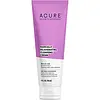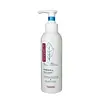What's inside
What's inside
 Key Ingredients
Key Ingredients

 Benefits
Benefits

 Concerns
Concerns

 Ingredients Side-by-side
Ingredients Side-by-side

Water
Skin ConditioningOlea Europaea Fruit Oil
MaskingSodium Cocoyl Isethionate
CleansingPotassium Olivoyl Hydrolyzed Wheat Protein
CleansingSodium Lauroyl Lactylate
EmulsifyingSodium Cocoyl Glutamate
CleansingGlycerin
HumectantAvena Sativa Kernel Flour
AbrasiveSodium PCA
HumectantCetearyl Alcohol
EmollientDisodium Cocoamphodipropionate
CleansingGluconolactone
Skin ConditioningGlyceryl Stearate Se
EmulsifyingTheobroma Cacao Seed Butter
EmollientGlyceryl Oleate
EmollientParfum
MaskingCitric Acid
BufferingGlyceryl Caprylate
EmollientPolysorbate 60
EmulsifyingCetearyl Glucoside
EmulsifyingGlyceryl Stearate
EmollientSorbitan Stearate
EmulsifyingCarrageenan
Potassium Sorbate
PreservativeMentha Viridis Leaf Oil
AstringentAloe Barbadensis Leaf Juice
Skin ConditioningAlcohol
AntimicrobialTocopherol
AntioxidantGlycine Soja Oil
EmollientChlorophyllin-Copper Complex
AntioxidantHyaluronic Acid
HumectantAspalathus Linearis Leaf Extract
Skin ConditioningCalendula Officinalis Flower Extract
MaskingChamomilla Recutita Flower Extract
MaskingEuterpe Oleracea Fruit Extract
Punica Granatum Extract
AstringentRosa Canina Fruit Extract
AstringentRubus Fruticosus Fruit Extract
AstringentWater, Olea Europaea Fruit Oil, Sodium Cocoyl Isethionate, Potassium Olivoyl Hydrolyzed Wheat Protein, Sodium Lauroyl Lactylate, Sodium Cocoyl Glutamate, Glycerin, Avena Sativa Kernel Flour, Sodium PCA, Cetearyl Alcohol, Disodium Cocoamphodipropionate, Gluconolactone, Glyceryl Stearate Se, Theobroma Cacao Seed Butter, Glyceryl Oleate, Parfum, Citric Acid, Glyceryl Caprylate, Polysorbate 60, Cetearyl Glucoside, Glyceryl Stearate, Sorbitan Stearate, Carrageenan, Potassium Sorbate, Mentha Viridis Leaf Oil, Aloe Barbadensis Leaf Juice, Alcohol, Tocopherol, Glycine Soja Oil, Chlorophyllin-Copper Complex, Hyaluronic Acid, Aspalathus Linearis Leaf Extract, Calendula Officinalis Flower Extract, Chamomilla Recutita Flower Extract, Euterpe Oleracea Fruit Extract, Punica Granatum Extract, Rosa Canina Fruit Extract, Rubus Fruticosus Fruit Extract
1,2-Hexanediol
Skin ConditioningWater
Skin ConditioningBisabolol
MaskingButyl Avocadate
Skin ConditioningCapryloyl Glycine
CleansingCetearyl Alcohol
EmollientCI 77891
Cosmetic ColorantCitric Acid
BufferingCoco-Glucoside
CleansingDisodium Cocoyl Glutamate
CleansingDisodium Lauryl Sulfosuccinate
CleansingGlycerin
HumectantGlyceryl Caprylate
EmollientGlycine Soja Oil
EmollientGlycine Soja Sterols
EmollientGlycolipids
Skin ConditioningHydrogenated Castor Oil
EmollientHydrolyzed Chenopodium Quinoa Seed
Skin ConditioningHydroxypropyl Guar
Emulsion StabilisingMaltodextrin
AbsorbentParfum
MaskingPhospholipids
Skin ConditioningPotassium Sorbate
PreservativeSodium Chloride
MaskingSodium Cocoyl Glutamate
CleansingSodium Cocoyl Isethionate
CleansingTocopherol
AntioxidantZea Mays Starch
AbsorbentZinc Gluconate
Skin Conditioning1,2-Hexanediol, Water, Bisabolol, Butyl Avocadate, Capryloyl Glycine, Cetearyl Alcohol, CI 77891, Citric Acid, Coco-Glucoside, Disodium Cocoyl Glutamate, Disodium Lauryl Sulfosuccinate, Glycerin, Glyceryl Caprylate, Glycine Soja Oil, Glycine Soja Sterols, Glycolipids, Hydrogenated Castor Oil, Hydrolyzed Chenopodium Quinoa Seed, Hydroxypropyl Guar, Maltodextrin, Parfum, Phospholipids, Potassium Sorbate, Sodium Chloride, Sodium Cocoyl Glutamate, Sodium Cocoyl Isethionate, Tocopherol, Zea Mays Starch, Zinc Gluconate
Ingredients Explained
These ingredients are found in both products.
Ingredients higher up in an ingredient list are typically present in a larger amount.
Cetearyl alcohol is a mixture of two fatty alcohols: cetyl alcohol and stearyl alcohol. It is mainly used as an emulsifier. Emulsifiers help prevent the separation of oils and products. Due to its composition, it can also be used to thicken a product or help create foam.
Cetearyl alcohol is an emollient. Emollients help soothe and hydrate the skin by trapping moisture.
Studies show Cetearyl alcohol is non-toxic and non-irritating. The FDA allows products labeled "alcohol-free" to have fatty alcohols.
This ingredient is usually derived from plant oils such as palm, vegetable, or coconut oils. There is debate on whether this ingredient will cause acne.
Due to the fatty acid base, this ingredient may not be Malassezia folliculitis safe.
Learn more about Cetearyl AlcoholCitric Acid is an alpha hydroxy acid (AHA) naturally found in citrus fruits like oranges, lemons, and limes.
Like other AHAs, citric acid can exfoliate skin by breaking down the bonds that hold dead skin cells together. This helps reveal smoother and brighter skin underneath.
However, this exfoliating effect only happens at high concentrations (20%) which can be hard to find in cosmetic products.
Due to this, citric acid is usually included in small amounts as a pH adjuster. This helps keep products slightly more acidic and compatible with skin's natural pH.
In skincare formulas, citric acid can:
While it can provide some skin benefits, research shows lactic acid and glycolic acid are generally more effective and less irritating exfoliants.
Most citric acid used in skincare today is made by fermenting sugars (usually from molasses). This synthetic version is identical to the natural citrus form but easier to stabilize and use in formulations.
Read more about some other popular AHA's here:
Learn more about Citric AcidGlycerin is already naturally found in your skin. It helps moisturize and protect your skin.
A study from 2016 found glycerin to be more effective as a humectant than AHAs and hyaluronic acid.
As a humectant, it helps the skin stay hydrated by pulling moisture to your skin. The low molecular weight of glycerin allows it to pull moisture into the deeper layers of your skin.
Hydrated skin improves your skin barrier; Your skin barrier helps protect against irritants and bacteria.
Glycerin has also been found to have antimicrobial and antiviral properties. Due to these properties, glycerin is often used in wound and burn treatments.
In cosmetics, glycerin is usually derived from plants such as soybean or palm. However, it can also be sourced from animals, such as tallow or animal fat.
This ingredient is organic, colorless, odorless, and non-toxic.
Glycerin is the name for this ingredient in American English. British English uses Glycerol/Glycerine.
Learn more about GlycerinGlyceryl Caprylate comes from glycerin and caprylic acid, a fatty acid from coconut. It has emollient and emulsifier properties.
As an emollient, it helps hydrate your skin. Emollients work by creating a barrier on your skin to trap moisture in, helping to keep your skin soft and smooth.
On the other hand, emulsifiers prevent ingredients (such as oil and water) from separating.
Learn more about Glyceryl CaprylateGlycine Soja Oil comes from the soybean. Glycine Soja is native to eastern Asia.
Soybean oil is an emollient. It is rich in antioxidants and fatty acids including palmitic, stearic, oleic, and linoleic acids.
As an emollient, the fatty acids in soybean oil helps keep your skin soft and hydrated. It does so by creating a film on top that traps moisture in.
Soybean oil is also rich in vitamin E, a potent antioxidant. Vitamin E is also anti-inflammatory and provides a soothing effect.
Studies show soy may help fade hyperpigmentation from UVB. It does so by disrupting the melanin process from UVB induced skin inflammation.
This ingredient may not be malassezia folliculitis, or fungal-acne, safe.
Soybeans are rich in proteins and are part of the legume family. Foods made with soybeans include tofu, soymilk, edamame, miso, and soy sauce.
Learn more about Glycine Soja OilParfum is a catch-all term for an ingredient or more that is used to give a scent to products.
Also called "fragrance", this ingredient can be a blend of hundreds of chemicals or plant oils. This means every product with "fragrance" or "parfum" in the ingredients list is a different mixture.
For instance, Habanolide is a proprietary trade name for a specific aroma chemical. When used as a fragrance ingredient in cosmetics, most aroma chemicals fall under the broad labeling category of “FRAGRANCE” or “PARFUM” according to EU and US regulations.
The term 'parfum' or 'fragrance' is not regulated in many countries. In many cases, it is up to the brand to define this term.
For instance, many brands choose to label themselves as "fragrance-free" because they are not using synthetic fragrances. However, their products may still contain ingredients such as essential oils that are considered a fragrance by INCI standards.
One example is Calendula flower extract. Calendula is an essential oil that still imparts a scent or 'fragrance'.
Depending on the blend, the ingredients in the mixture can cause allergies and sensitivities on the skin. Some ingredients that are known EU allergens include linalool and citronellol.
Parfum can also be used to mask or cover an unpleasant scent.
The bottom line is: not all fragrances/parfum/ingredients are created equally. If you are worried about fragrances, we recommend taking a closer look at an ingredient. And of course, we always recommend speaking with a professional.
Learn more about ParfumPotassium Sorbate is a preservative used to prevent yeast and mold in products. It is commonly found in both cosmetic and food products.
This ingredient comes from potassium salt derived from sorbic acid. Sorbic acid is a natural antibiotic and effective against fungus.
Both potassium sorbate and sorbic acid can be found in baked goods, cheeses, dried meats, dried fruit, ice cream, pickles, wine, yogurt, and more.
You'll often find this ingredient used with other preservatives.
Learn more about Potassium SorbateSodium Cocoyl Glutamate is a gentle cleanser and surfactant. It is the sodium salt of the Cocoyl Glutamic Acid and comes from coconut oil. As a surfactant, it helps lift dirt and oil to be washed away.
Sodium Cocoyl Glutamate also has an emolliating effect and can help leave the skin feeling soft.
Sodium cocoyl isethionate is a natural ingredient from coconut oil. It is an ultra gentle cleanser that gives a nice foam without drying the skin or impacting the skin barrier.
The amount of foam created depends on the amount of sodium cocoyl isethionate used in the product.
This ingredient also helps improve the spreadability of a product.
Learn more about Sodium Cocoyl IsethionateTocopherol (also known as Vitamin E) is a common antioxidant used to help protect the skin from free-radicals and strengthen the skin barrier. It's also fat soluble - this means our skin is great at absorbing it.
Vitamin E also helps keep your natural skin lipids healthy. Your lipid skin barrier naturally consists of lipids, ceramides, and fatty acids. Vitamin E offers extra protection for your skin’s lipid barrier, keeping your skin healthy and nourished.
Another benefit is a bit of UV protection. Vitamin E helps reduce the damage caused by UVB rays. (It should not replace your sunscreen). Combining it with Vitamin C can decrease sunburned cells and hyperpigmentation after UV exposure.
You might have noticed Vitamin E + C often paired together. This is because it is great at stabilizing Vitamin C. Using the two together helps increase the effectiveness of both ingredients.
There are often claims that Vitamin E can reduce/prevent scarring, but these claims haven't been confirmed by scientific research.
Learn more about TocopherolWater. It's the most common cosmetic ingredient of all. You'll usually see it at the top of ingredient lists, meaning that it makes up the largest part of the product.
So why is it so popular? Water most often acts as a solvent - this means that it helps dissolve other ingredients into the formulation.
You'll also recognize water as that liquid we all need to stay alive. If you see this, drink a glass of water. Stay hydrated!
Learn more about Water